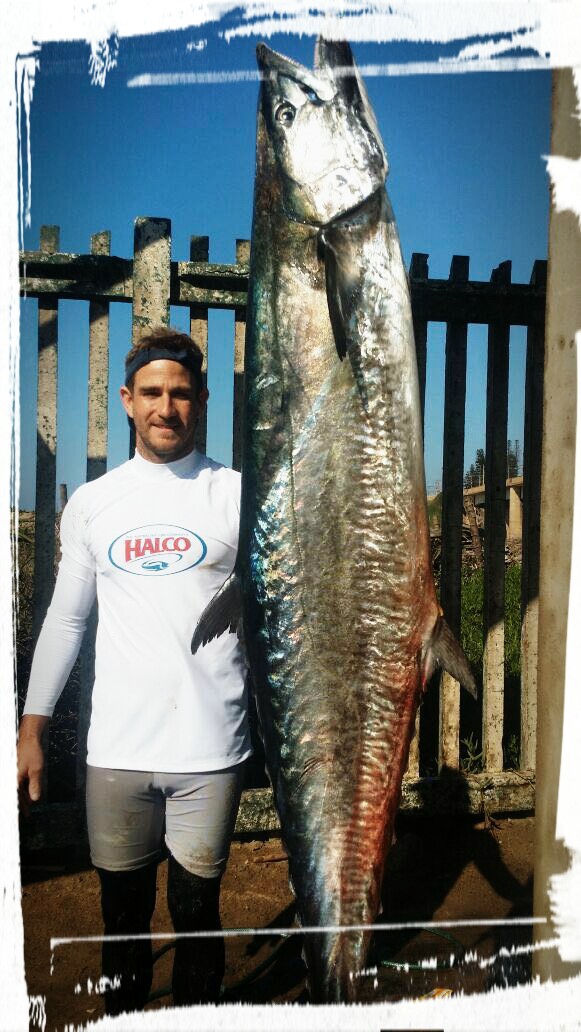
Final word on huge king mackerel run?
Now that the bite has slowed down here on the lower south coast of Kwazulu Natal, South Africa – could this be the final word on this years huge king mackerel run?
Well this fish could be. The fish of the season so far too…taken off Umkomaas on a ski! Weighed in between 45 and a possible 55kg’s.

It was also one of the very last fish recorded so far. At the Port Edward deep-sea competition, not even one couta was weighed in. The competition was won with a 30kg yellowfin tuna. Bonito and bait was everywhere – but unbelievably, not even one king mackerel.
As the season nears the end – about late July-ish, the chances of more of these amazing class of fish being caught bigger than the one featured, are very slim. They have disappeared from down here.
But, as we have been taught as of late, that anything can happen?! Who would have guessed in a million years that these huge fish would come and hang out here off Port Shepstone and Port Edward, season after season like this. I mean, yes, we have caught 30kg+ fish before, but only after 30 years of trying!
![sean-kuta-32kg-010306-028-768x1024[1]](https://thesardine.co.za/wp-content/uploads/2016/06/sean-kuta-32kg-010306-028-768x10241-768x1024.jpg)
One is by the resourceful and acclaimed scientist Pat Garrat, whom I saw in the early 1990’s, release his paper on “The end of a species”. He was citing research and contemporary situations at that time, pertaining to the slinger and the red steenbras. The two species had been studied by Pat and his associates, and observation with major impact were being made.
Polla Fourie, a commercial fisher at the same symposium, had been lobbying to have the restriction on red steenbras lifted or eased, as he was catching such good fish. Pat Garrat was opposing this claim and request, with research done with isolated slinger populations, on the north coast. As a population was depleted, the mean size increased.
Pat was citing lions and elephants and all manners of animals under threat. The last lion is the biggest and most wily. The last elephant. The last shark. As the less experienced and perhaps slower shoal sized fish are removed, the bigger ones get bigger. Survival of the fittest. And the biggest.
The other theory I have heard lately, is that perhaps these big fish have decided to just live in this area, what with all the bait and up coming sardine run to keep them interested. Some of these fish were taken in August, way down into the Transkei.
Craig Pretorious down in Port Edward, was chatting to some ORI staff who speculate that maybe these big fish come here to be put out to pasture? Like a couta old age home?
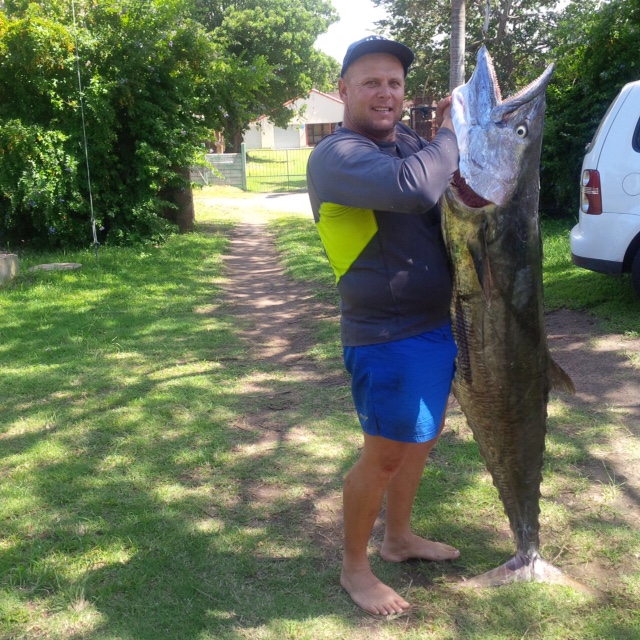
Well…
These fish were survivors through all the nets, lines and traps set for them over the last twenty to thirty years, as they traverse the Indian Ocean, growing at about 2kgs per year. They must have all hatched together, perhaps on the south coast (couta spawn way up in the tropics and their fry is brought on down to us. Then it heads it’s way back into the tropics. Couta are very seldom found in water below 23 degrees. Although they are recorded as in the past being prevalent in False Bay, Cape Town, where they were known as Katonkel. Mossell Bay officially recorded couta catches back in the days – it makes sense that as the overall population shrinks, the outer perimeters of it’s roaming waters are shrivelling).
But King Mackerel, in order to spawn, aggregate in specific areas to facilitate this. And so perhaps, the south coast over the last few years, has been a great place for spawning for these mature fish. The water hasn’t been that polluted or brown around here for quite some time through the drought of the last few years, almost a decade now. Loads of baitfish including sardines.
Fish behavior after spawning is dictated to by the energy spent during the spawn. Couta have to chow down and fast. And this is is when and where those chance encounters between recreational anglers and spawning sessions happen.
Fish are known to choose their spawning time over seasons to coincide with lunar movement and activity. So much so, that in Belize, when the snapper proffer their clouds of caviar, the whale sharks know exactly when to be there to take their(lions) share of the hopeful offspring.
So it’s that moon after all!
Getting technical…
In South Africa: king mackerel, couta, cuda, but throughout their distribution…
- Malaysia: tenggiri
- Mozambique: Sierra
- Australia: narrow-bar, narrow-barred mackerel, snook, Spaniard, Spanish mackerel
- USA: barred mackerel, narrow-barred mackerel, striped seer
- Arabia: kanaad, kanad or kana’d mackerel
- India: konem in Telugu, vanjaram in Tamil, anjal in Tulu
- Iran: shir mahi
- Israel: Palamida
- Philippines: tanigue
- Indonesia: ikan tenggiri
- Sri Lanka: Thora
- Somalia: Yuumbi
- Fiji: walu
- Thailand: pl? xinthr?
Maybe they head up to Mozambique and across the channel to Madagascar? Or to the attolls and deep underwater mountains? These fish have to eat a lot to keep going. They need steady supplies of ribbonfish, mackerel, sardines, anchovies, bonito etc…maybe they just go up towards Sodwana and Kosi area and hang out there. That area is also known to have produced some really big couta before. (And lately)
Lucky Egyptians also catch couta on the northen Egyptian coastline, as do the Israeli sportfishing contingent. Unfortunately, many, many fish catching and processing and exporting business’ operate in this area. Taking boatloads of fish out every year. But the couta seem to have adapted well and have been breeding and growing very successfully.
David Kosta and his mates have been successfully bringing home trophy sized king mackerel…in the Med.
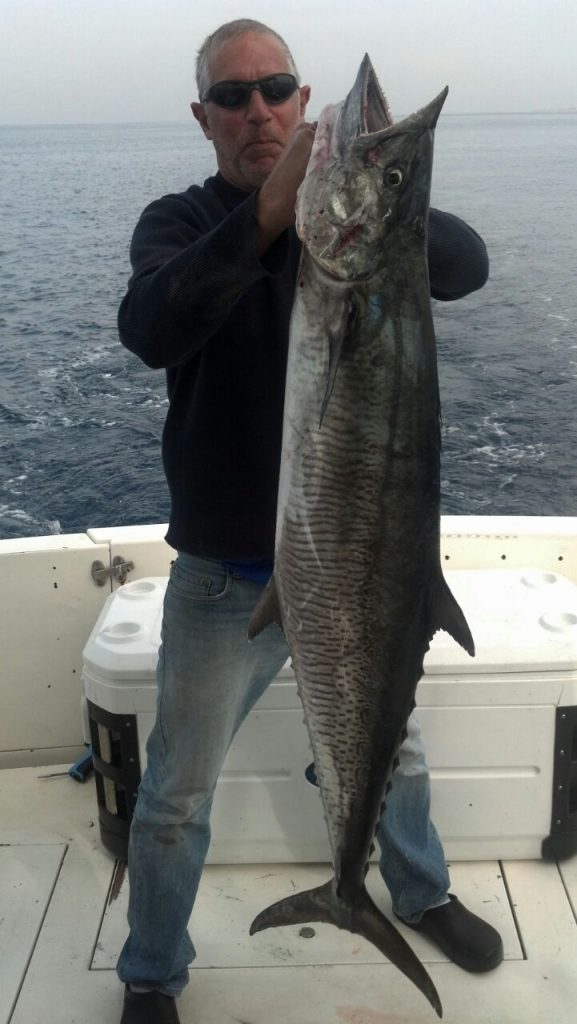
Click here for the full story of David Kosta and his successes using deep swimming MYDO Baitswimmers for huge Amberjack and Couta.
So this population seems to be alive and well and sort of cut off to the rest by the Suez Canal. Interesting situation. Hope these colonists can hold onto power! But at what expense to the residents of the Med. Having a huge aggressive predatory fish come along into a peaceful neighbourhood can have disastrous results. Check out what the Nile Perch did to clean old Lake Victoria. They ate all the chiclids and other nice fishies, leaving plankton like creatures to bloom and discolour the waters as they have.
Ok, but moving on and passing by India, the couta is again an important source of protein and therefore valuable enough to be chase to the horizons by dozens of commercial operations. South East Asia is about the mid point of the couta’s distribution around the Indian Ocean coastlines. They are hammered here too. It’s only when the fish get past Indonesia and trickle on down both east and western coasltlines of Australia, do they find any real respite or protection.
They are also found swimming as far north as China and Japan. Highly sought after table fish.
The waters couta patrol are from near the edge of continental shelf to shallower waters. 5 To 25 metres. Drop-offs, shallow or gently sloping reef and lagoon waters are the right places to hunt for them. Solitary hunters they swim in shallow water along coastal reefs, bays, and around headlands. They undertake lengthy migrations up and down certain coastlines, but permanent resident populations also exist. Up until they are about 5 to 8kgs, they swim and migrate in shoals.
Couta feed primarily on small fishes like sardines, anchovies, mackerel, bonito and squids.
Eggs and larvae are pelagic. Couta spawn around reefs, in ideal warm water conditions. Eggs have an oil droplet that keeps them at the surface. The oxygen and abundant plankton nourish them. The larvae develop and move towards estuarine and calmer waters. You can see baby couta circling Paradise Island in the Bazaruto Archipelego and are caught in the nets deployed off Inhassoro and Vilancoulos, daily and throughout the year.
Female Couta become sexually mature at about two and a half years of age or around 80 cm.
The Almanac type predictions were similar all week that week, they all predicted higher than average fish activity, early to mid morning. The day before however, Marc and Brian Lange, had spent the afternoon and into the evening, til midnight, fishing the exact same spot for couta, with livebait, and caught nothing. Not a strike. Then Marc relaunched in the morning – keen bugger he is, and got into these 9 fish. At the end of the day, just as the tide was dictating for them to get back into the Umzimkulu mouth, a huge couta came screaming in at Marc’s last live shad. His instinct, after loading nine fish, was to pull the shad out of harms way. They packed up and went home. It took 3 hours to hook and load all the fish. They never lost one – nine strikes, nine fish.
A few days later…Mark Snyman, William Robertson and Lance Dunn came in with this catch…on the 28 May 2016. One week later. 10 Nautical miles due south of Marc and Koos’s catch.
The Tides4Fishing Almaniacal prediction was for very high fishing activity but very early that morning. So far so good, two out of two predictions were bang on.
If those fish spawned just before the good fishing that was experienced, – then we can learn when to fish for these crocodile couta. When the moon is directly overhead, or underfoot – those are meant to be the right times.
Where do they simply disappear to? Where do they come from?
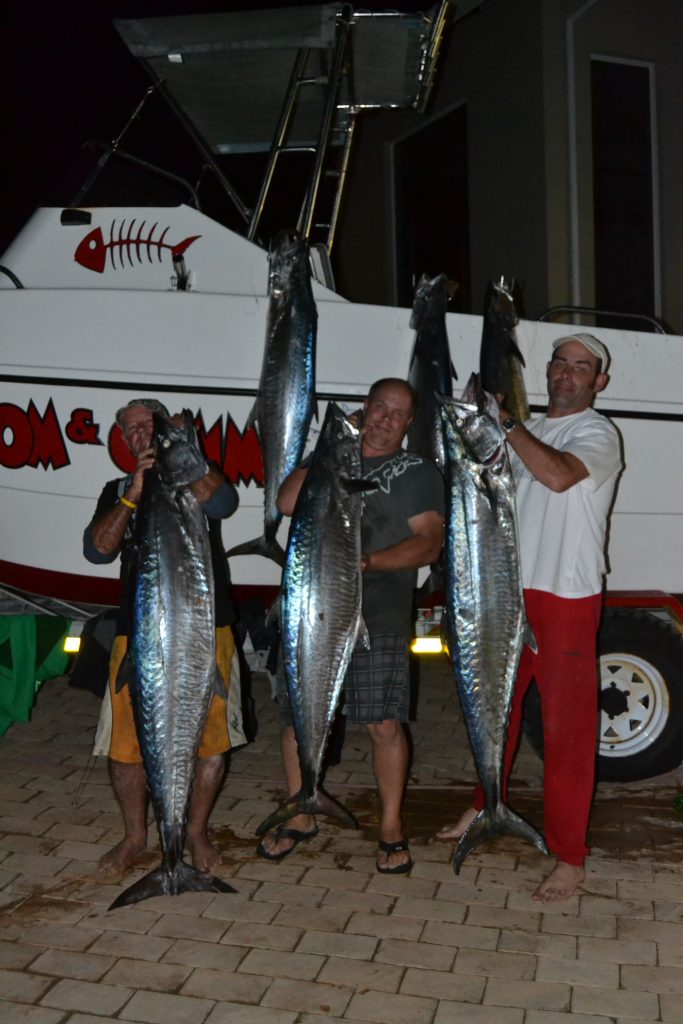
Louis Posthumous, his son Shawn and Neil Allchin caught these fish when the Almanac said fishing would be good early that morning.
And in a final twist, and a possible clue – Ettienne Thiebauts paddling off Cape Vidal, hauled in a confirmed 46 kg king mackerel, on Friday 17 June 2016.

The fishing was forecast good for around 10 am in the morning, kak through the day, and one more hit of chance at 3pm in the afternoon.
One thing is for sure, we will be eagerly awaiting this run again next year.
Now, let’s see who will be the first to tag and release one of these majestic fish?!
References and acknowledgements:
McPherson, G.R., 1992. Age and growth of the narrow-barred Spanish mackerel (Scomberomorus commerson Lacepède, 1800) in north-eastern Queensland waters. Aust. J. Mar. Freshwat. Res. 43(5):1269-1282.
Ends

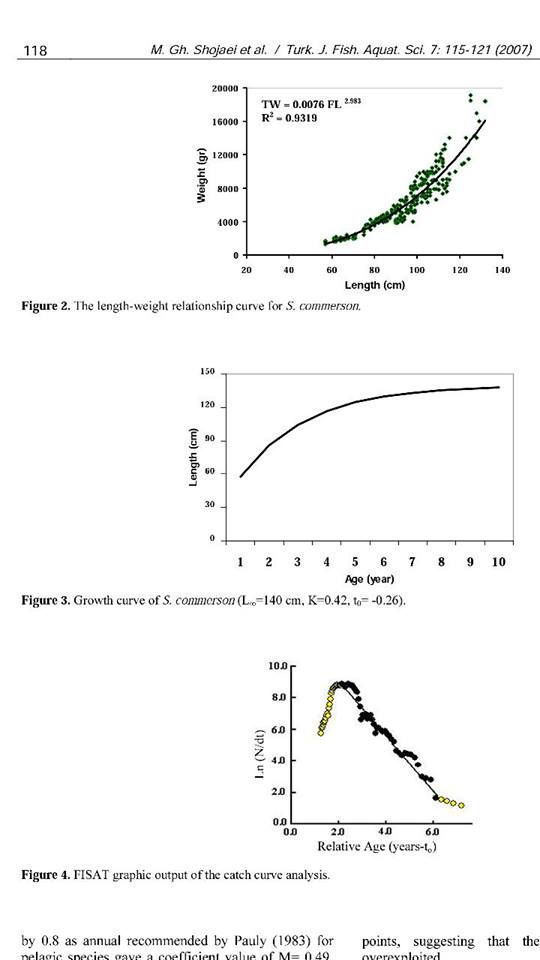
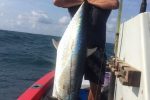
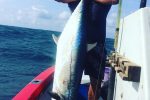
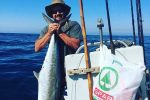
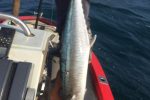
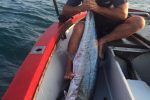
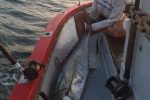
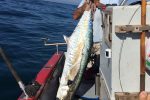
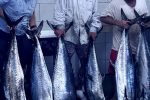

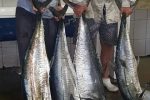
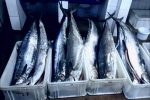
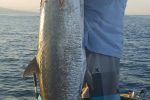
[…] via Final word on huge king mackerel run? — thesardine.co.za […]
[…] via Final word on huge king mackerel run? — thesardine.co.za […]
[…] via Final word on huge king mackerel run? — thesardine.co.za […]
[…] via Final word on huge king mackerel run? — thesardine.co.za […]